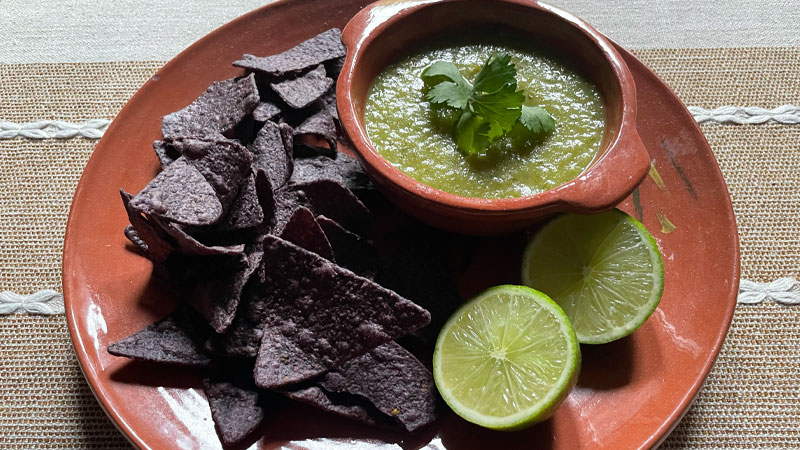Tequila’s rich depth of flavors and broad range of styles make it a versatile ingredient behind the bar. Those same facets also allow the agave distillate to shine in the kitchen, though it’s an arena that has often seen the ingredient go underused and underappreciated.
The traditional Mexican salsa borracha (drunken salsa) uses warm pulque or light beer to rehydrate pasilla chilies, which are then blended with fresh onions and garlic into a rich, spicy condiment. Some cooks also add a few splashes of tequila to the warmed liquid to provide extra flavor and bring the nation’s most famous distillate into the kitchen. Anyone wishing to go a step further and allow tequila’s profile to take the culinary center stage can seek inspiration from salsa borracha and riff on another of Mexico’s wonderful sauces: salsa verde.
A common accoutrement in taquerias, salsa verde is also an important ingredient when cooking dishes such as enchiladas verdes and tamales de pollo en salsa verde. The earthy green sauce gains a bright, sweet profile from a base of tomatillos, and intense flavor from raw onions, garlic, chili peppers, and cilantro. With its green, vegetal profile, tequila is perfectly suited to pair with these flavors and add dazzling extra layers to the sauce. It should be stressed that incorporating the agave spirit in the recipe yields a non-traditional salsa verde. But it’s a delicious means of utilizing tequila in cooking, drawing inspiration from both salsa verde and salsa borracha, and delivering a complex condiment that can be cooked with and used as a taco topping or dip for chips.
The first step during any salsa verde preparation is cleaning, then cooking the tomatillos. Traditionally, and most simply, this can be achieved by boiling the husked, washed fruit in water along with some optional serrano or jalapeño peppers. Alternatively, the tomatillos can be sliced in half, lightly seasoned with salt and pepper, and cooked under a broiler. This process intensifies the fruit’s sweet flavors, while adding charred notes to the final sauce via the now-black, blistered skins.
The tomatillos should be left to cool down to room temperature after cooking, with any liquid that’s escaped from the fruit set aside for use during blending. We’re also including two large charred poblano peppers in this recipe (another non-traditional departure) to provide further smoky green notes that will highlight the profile of tequila in the finished sauce.
Before we arrive at the tequila, a quick note on the raw ingredients: Onion, garlic, cilantro, and jalapeño are included uncooked to maintain vibrant character and contrast to the cooked notes of the tomatillos and poblano peppers. If you typically find raw onion’s flavor to be overpowering, soaking the minced vegetable in cold water for five minutes helps remove its bite.
Given that we’re custom-preparing this sauce to accommodate tequila, choosing which bottle to incorporate should not be an afterthought. With all the flavors geared toward tequila’s earthy, vegetal notes, a bottle that maintains the character of agave is imperative. And given the sweetness from the roasted tomatillos, a slightly aged style, such as reposado, is the ultimate option. With both these considerations in mind, we favor Tequila Ocho Reposado, but there are a number of suitable candidates in VinePair’s most recent tequila roundup. (Consider also using half tequila and half mezcal to add a further smoky seasoning to the sauce.)
While the recipe calls for scant more tequila than you might mix in a standard Margarita, don’t be tempted to add more. Just a few ounces allow the spirit’s flavor to arrive piercing, powerful, and — most importantly — balanced in the finished sauce.
When blending all the ingredients together, the reserved liquid from the roasted tomatillos can be used to adjust its consistency, depending on whether you want a thicker dipping sauce for chips, or a slightly thinner sauce that will reduce if used for cooking.
After blending, one final step sees the sauce cooked for a few minutes in a pan over high heat. This removes some of the booze from the spirit that can otherwise stand out awkwardly and taste disjointed. The process also brings all the flavors together and increases the intensity of its profile.
The Tequila-Spiked Salsa Verde Recipe
Makes 4 cups
Ingredients:
- 9 medium tomatillos (1 ½ pounds)
- 2 large poblano peppers (2 ½ ounces)
- 1 medium white onion, minced (6 ounces)
- 2 cloves garlic, peeled and minced
- 2 jalapeño peppers, stemmed and seeded
- 20 sprigs of cilantro, thick stems removed
- 3 ounces reposado tequila, such as Tequila Ocho
- 2 tablespoons olive olive, plus more for drizzling
- Juice of 1 lime
- Salt and pepper, to taste
Directions:
- Slice the tomatillos in half and place skin side up on a baking sheet lined with aluminum foil. Season with salt and pepper and place under the broiler until charred and soft, around 4 to 5 minutes.
- Remove tomatillos from the oven and leave to cool to room temperature. Separate and reserve any liquid that’s escaped from the fruit during cooking.
- Repeat the process with the poblano peppers, seasoning with salt, pepper, and a drizzle of olive oil. Cook under the broiler until charred, turning every few minutes so that all sides gain color.
- Remove from the oven when soft and blackened. Peel off the charred skin, remove the stems and seeds, and cool to room temperature.
- Add tomatillos, poblano peppers, onion, garlic, jalapeños, cilantro, and tequila to a blender. Pulse until all ingredients are broken down, but avoid blending for too long and reaching a velvet smooth consistency. For a thinner sauce, add reserved tomatillo cooking liquid.
- Heat 2 tablespoons of olive oil in a pan that will comfortably hold all the sauce. When the oil reaches a high temperature, add the sauce and stir immediately. Do not let the sauce catch on the base of the pan, and avoid any hot splashes of oil and sauce. Cook over medium heat for 2 to 3 minutes.
- Cool to room temperature then season to taste with salt, pepper, and fresh lime juice as needed.
- Serve with tortillas chips or your preferred tacos.

